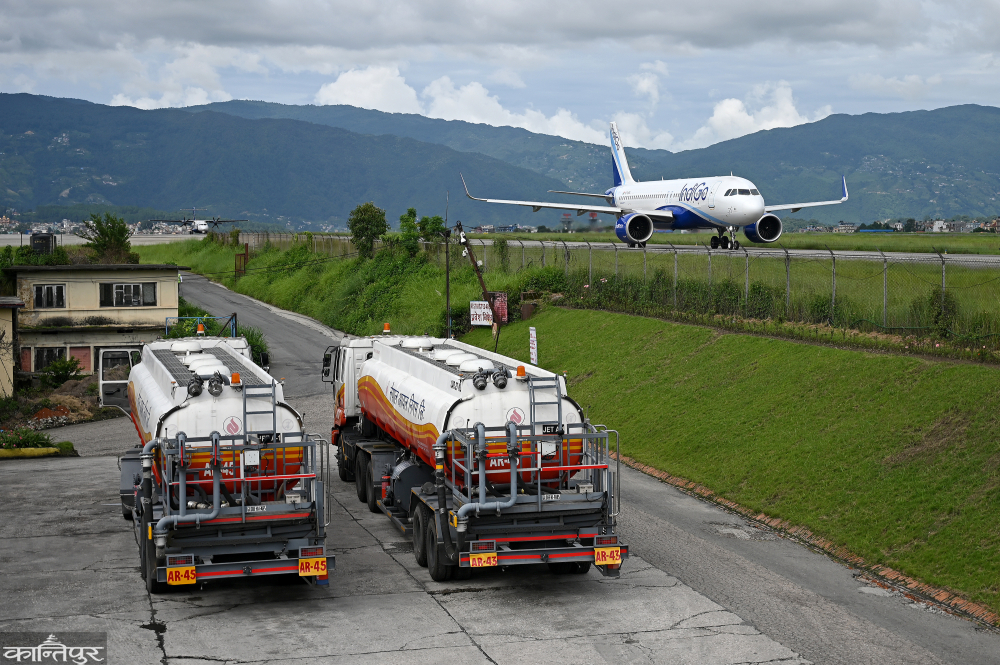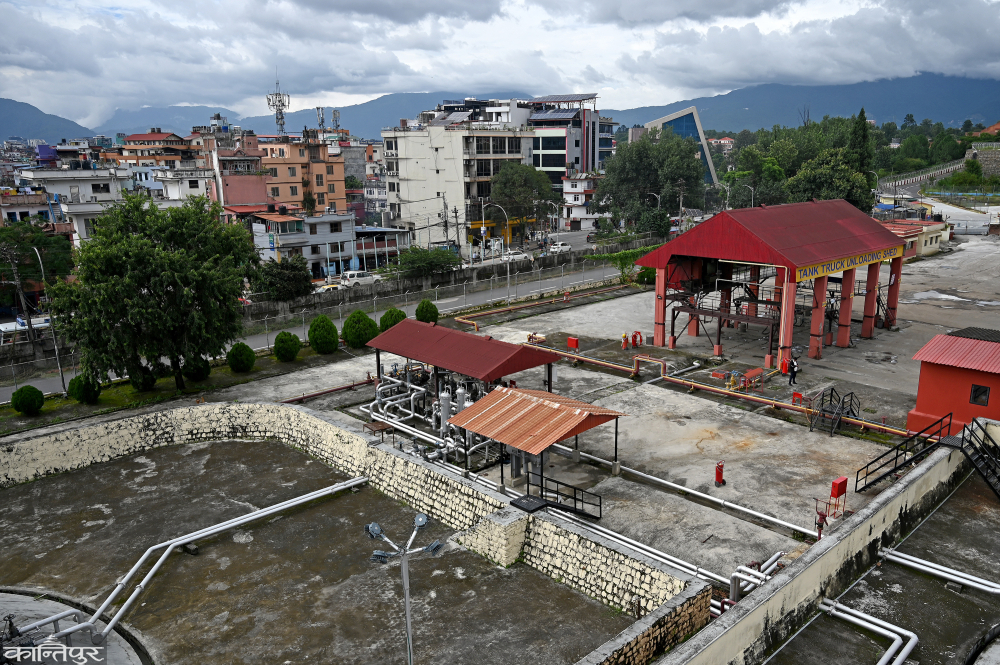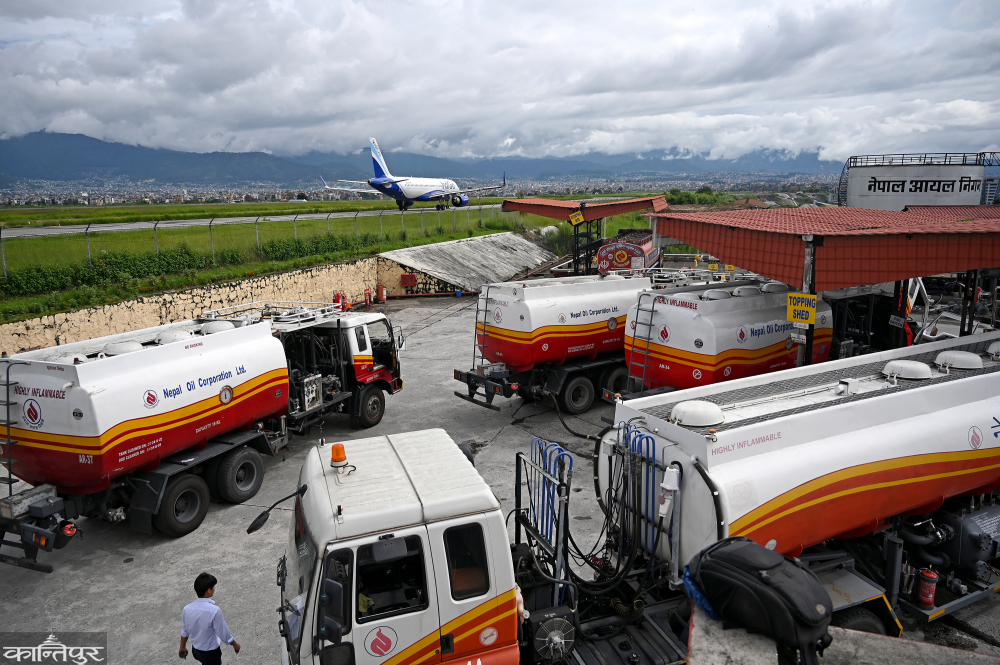Fuel depots along runways, overcrowded at risk

We use Google Cloud Translation Services. Google requires we provide the following disclaimer relating to use of this service:
This service may contain translations powered by Google. Google disclaims all warranties related to the translations, expressed or implied, including any warranties of accuracy, reliability, and any implied warranties of merchantability, fitness for a particular purpose, and noninfringement.

Highlights
- According to ICAO standards, there should be a 'taxi-way' at a distance of 172.5 meters from the runway, and fuel storage should be at least 90 meters away from that, but at Tribhuvan International Airport, there is a storage of 7.6 million liters of fuel within 80 meters from the runway.



In a decade, three major plane crashes took place inside the Tribhuvan International Airport. On February 20, 2071, Airbus 320-303, which came from Istanbul, Turkey with 223 passengers to Kathmandu, crashed inside the airport, but there were no casualties. 51 people including the crew died in the US-Bangla plane crash on February 28, 2074. On July 9, a Sourya Airlines plane crashed inside the airport, killing 18 people.

If any of these three ships had reached towards the 6 vertical tanks and 8 underground tanks of Nepal Oil Corporation stored at Sinamangal, not only the passengers but also the surrounding human settlements would have suffered great damage. Even if accidentally avoided so far, the risk remains.
The depot of aviation fuel, which is considered very sensitive, is about 80 meters away from the runway of Tribhuvan Airport. Ships keep coming around. Sometimes when the ship slips and hits the aviation fuel depot kept by the corporation, Pradeep Yadav, Head of Aviation Fuel Depot Office of Nepal Oil Corporation, Sinamangal, says, "Innumerable people are killed within 10 minutes."
 When a ship crashes, the death of the passenger is usually caused by the fire caused by the fuel. Most of the people die on the spot after the accident due to fuel spillage and fire. In such a situation, the depot chief Yadav said that if there is an accident, the tanks of the shipping corporation will also enter the human settlements. 7.644 thousand liters of aviation fuel are stored in 6 vertical tanks and 8 underground tanks kept at Sinamangal depot. "If the ship slips from the runway and hits the vertical tank, the fuel will flow from Sinamangal to Wagmati Corridor," said Yadav, "unthinkable human losses will have to be borne."
When a ship crashes, the death of the passenger is usually caused by the fire caused by the fuel. Most of the people die on the spot after the accident due to fuel spillage and fire. In such a situation, the depot chief Yadav said that if there is an accident, the tanks of the shipping corporation will also enter the human settlements. 7.644 thousand liters of aviation fuel are stored in 6 vertical tanks and 8 underground tanks kept at Sinamangal depot. "If the ship slips from the runway and hits the vertical tank, the fuel will flow from Sinamangal to Wagmati Corridor," said Yadav, "unthinkable human losses will have to be borne."
 The plan to move fuel storage after studying this risk is from 2018. However, due to the lack of inter-governmental coordination, the process of contracting and land transactions between the authority and the corporation has not been started. According to Yadav, the plane of Turkish Airlines crashed about 30 meters from the vertical tank.
The plan to move fuel storage after studying this risk is from 2018. However, due to the lack of inter-governmental coordination, the process of contracting and land transactions between the authority and the corporation has not been started. According to Yadav, the plane of Turkish Airlines crashed about 30 meters from the vertical tank.
Surya's ship had an accident while taking off from the south side. If the same plane had taken off from the north to the south, it could have hit the corporation's tank,'' said Yadav. According to the standards of ICAO and the master plan of Tribhuvan International Airport, the Civil Aviation Authority of Nepal is working to expand the infrastructure within the airport. Now the extended 'taxi way' and air fuel tank will be near.
 Nepal Oil Corporation, Head of Aviation Fuel Depot Office Sinamangal Pradeep Yadav
Nepal Oil Corporation, Head of Aviation Fuel Depot Office Sinamangal Pradeep Yadav
'The depot must be relocated according to the master plan. We have written to the Corporation several times for this, but the Corporation has not shown any interest," said Dipendra Shrestha, Director of the Air Transport Capacity Enhancement Project under the Nepal Civil Aviation Authority. '
Corporation has a tank on 32 ropani land. Although the authority has sent letters 4 times since July 2079 for the transfer of air tanks, there has been no hearing. According to ICAO standards, the distance between the center line of the runway and the taxiway should be 172.5 meters. Shrestha said that although there is no definite standard as to how far the fuel depot should be, it should be at least 90 meters away from the taxi-way. But now the tank is only 80 meters from the runway.
 Although it has been confirmed for a long time that the tank will be transferred, the delay is due to the risk of contract management. Although they tried to move the depot two years ago, they could not move forward due to the maneuvering of interest groups. The study showed the cost to be 6 billion, there was pressure from the ministry to increase the cost. The contractors were also manipulated in this," said an official of the corporation. "The decision-making officials hesitated seeing that, they did not want to get into a dispute." According to the corporation, some interest groups have been "lobbying" to kill the contract. According to that official, the Indian Oil Corporation (IOC) is also interested in the contract to move the depot. The other side is in the 'lobbying' that should be done by Nepali companies. As billions of rupees will be released by handing it over to the IOC, he is on the side that the Nepali company should do it.
Although it has been confirmed for a long time that the tank will be transferred, the delay is due to the risk of contract management. Although they tried to move the depot two years ago, they could not move forward due to the maneuvering of interest groups. The study showed the cost to be 6 billion, there was pressure from the ministry to increase the cost. The contractors were also manipulated in this," said an official of the corporation. "The decision-making officials hesitated seeing that, they did not want to get into a dispute." According to the corporation, some interest groups have been "lobbying" to kill the contract. According to that official, the Indian Oil Corporation (IOC) is also interested in the contract to move the depot. The other side is in the 'lobbying' that should be done by Nepali companies. As billions of rupees will be released by handing it over to the IOC, he is on the side that the Nepali company should do it.
 2081 After the plane crash of Solar Airlines on July 9, the debate about depot transfer has heated up. Last Friday, Prime Minister KP Sharma Oli gave instructions to transfer the depot. The next day, on Saturday, a team including Industry, Commerce and Supply Minister Damodar Bhandari, Industry Secretary Krishna Bahadur Raut, Commerce and Supply Secretary Madhusudan Burlakoti, and Corporation Executive Director Chandika Bhatt inspected the land. Discussions are being held between the authority and the corporation soon after, but the transfer process has not progressed. Corporation's Sinamangal Aviation Fuel Depot Chief Yadav has written to the Authority on July 1 to organize a discussion between the higher level (Director General and Executive Director).
2081 After the plane crash of Solar Airlines on July 9, the debate about depot transfer has heated up. Last Friday, Prime Minister KP Sharma Oli gave instructions to transfer the depot. The next day, on Saturday, a team including Industry, Commerce and Supply Minister Damodar Bhandari, Industry Secretary Krishna Bahadur Raut, Commerce and Supply Secretary Madhusudan Burlakoti, and Corporation Executive Director Chandika Bhatt inspected the land. Discussions are being held between the authority and the corporation soon after, but the transfer process has not progressed. Corporation's Sinamangal Aviation Fuel Depot Chief Yadav has written to the Authority on July 1 to organize a discussion between the higher level (Director General and Executive Director).
The authority had also given the time of July 4. After that, the discussion between the two agencies has progressed. Chandika Bhatt, executive director of the corporation, said that the airport's taxi-way has been extended and the air fuel depot has come very close. "The authority to move the depot has already studied and allocated a place, now we will proceed according to the instructions given by the Ministry of Industry," he said.
 Minister Bhandari stressed that the current structure should be transferred safely as soon as possible. The Prime Minister has also issued an instruction regarding the transfer of the depot. On behalf of the Ministry of Industry, Commerce and Supply, we have instructed the corporation to study," Bhandari told Kantipur, "The authority's proposal is to move the fuel depot of the airport while expanding the airport. The Nepali Army also has a similar proposal. We have advanced the discussion after the instructions of the Prime Minister.'
Minister Bhandari stressed that the current structure should be transferred safely as soon as possible. The Prime Minister has also issued an instruction regarding the transfer of the depot. On behalf of the Ministry of Industry, Commerce and Supply, we have instructed the corporation to study," Bhandari told Kantipur, "The authority's proposal is to move the fuel depot of the airport while expanding the airport. The Nepali Army also has a similar proposal. We have advanced the discussion after the instructions of the Prime Minister.'
The Authority had studied in 2018 for the relocation of the air fuel depot. According to the study, an investment of 6 billion rupees is required to relocate the air fuel depot. Costs are expected to rise further due to price hikes. He said that international donors or Indian Oil Corporation's investment will also be discussed for that.
 According to the standards of ICAO, the authority conducted a study on air fuel transfer from Germany's Hansa Consultancy. With the help of Asian Development Bank (ADB), a study was conducted for the expansion of the airport and the safe relocation of the depot. "Hansa has designed more than 100 airports in the world, which has been given to the corporation," said Yadav, head of the corporation's Sinamangal depot Studies have shown that it is safe. The authority has already ensured that around 50 acres of land will be provided to the corporation. The proposed depot is about 500 meters away from the runway of the airport, said Dipendra Shrestha, director of the Air Transport Capacity Enhancement Project. Even if the ship slips and crashes, it will crash into the international terminal. It does not reach the depot.
According to the standards of ICAO, the authority conducted a study on air fuel transfer from Germany's Hansa Consultancy. With the help of Asian Development Bank (ADB), a study was conducted for the expansion of the airport and the safe relocation of the depot. "Hansa has designed more than 100 airports in the world, which has been given to the corporation," said Yadav, head of the corporation's Sinamangal depot Studies have shown that it is safe. The authority has already ensured that around 50 acres of land will be provided to the corporation. The proposed depot is about 500 meters away from the runway of the airport, said Dipendra Shrestha, director of the Air Transport Capacity Enhancement Project. Even if the ship slips and crashes, it will crash into the international terminal. It does not reach the depot.
 Minister of Industry, Commerce and Supply Damodar Bhandari monitoring the proposed fuel storage site.
Minister of Industry, Commerce and Supply Damodar Bhandari monitoring the proposed fuel storage site.
 The ship crash is during landing and take-off, when taking off from South, the ship has a speed of at least 200 km. After traveling 500 meters to 1 km, the ship takes off. Now the depot comes in between," Yadav said. "If the ship slips on the runway, it will hit the tank going west. The structure that is supposed to move the depot is in the ditch, so there is less chance of the ship colliding.'
The ship crash is during landing and take-off, when taking off from South, the ship has a speed of at least 200 km. After traveling 500 meters to 1 km, the ship takes off. Now the depot comes in between," Yadav said. "If the ship slips on the runway, it will hit the tank going west. The structure that is supposed to move the depot is in the ditch, so there is less chance of the ship colliding.'
According to the instructions of the government, the new depot will have a capacity of 15,000 to 20,000 kiloliters. Now there is only 15 days of paddy capacity on an average. Now the new depot will have a capacity of 1 month. The method of refueling the ship will also vary. At present the ship is refueled by bowser (tanker). The international usage is 'hydrant system'. Depot head Yadav says that the same system can be used in Nepal if the depot is transferred. "After starting the motor, the aerial fuel is loaded directly into the ship," he said.

 प्रकाशित : श्रावण २५, २०८१ ०६:१८
प्रकाशित : श्रावण २५, २०८१ ०६:१८

 ३०.१२°C काठमाडौं
३०.१२°C काठमाडौं













